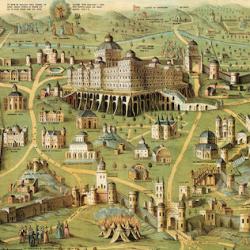INTRODUCTION
During the reign of wicked Ahaz, Judah moves closer to Israelite and Gentile idolatry. Ahaz foolishly jumps onboard the ship of Israel just as it begins to sink.
THE TEXT
“In the seventeenth year of Pekah the son of Remaliah, Ahaz the son of Jotham, king of Judah, began to reign. 2 Ahaz was twenty years old when he became king, and he reigned sixteen years in Jerusalem . . . .” (2 Kings 16:1-20).
EVIL KING
The evaluation of Ahaz is more severe than for any king of Judah other than Manasseh. He follows the ways of Israel’s kings rather than David. Ahaziah of Judah did the same (cf. 8:25), but he had the “excuse” of being related to Ahab. Ahaz has no such pressure, and pursues idolatry from the sheer willfulness of his heart. He even goes beyond that, pursuing the customs of the nations that Israel originally displaced from the land in the conquest (v. 3). An abomination (v. 3) defiles the land, and causes the land to expel the inhabitants. The writer emphasizes that worship is conducted “under every green tree” (v. 4; cf. 1 Kings 14:23), in contrast with Solomon’s time, when Judah and Israel all rejoiced under their vines and fig trees.
JUDAH AND ASSYRIA
Ahaz is threatened from the north by Israel and Aram, now allied against Assyria (Isaiah 7). Pekah is able to capture a town of Judah (v 6), driving the inhabitants into a mini-exile. Instead of turning in prayer to the temple, Ahaz plunders the temple and the palace for a bribe. He declares himself a covenant vassal, a “son ands servant” of Assyria (v. 7), in order to get help from Tiglath-pileser. Assyria attacks from the north, takes Damascus and the Arameans into exile. Israel’s exile is in some measure self-inflicted: Ahaz pays for Assyria to start conquering the Northern Kingdom.
Ahaz goes to visit Tiglath-pileser at Damascus, perhaps to formally seal their alliance. The writer’s attention, though, it focused on Ahaz’s interest in the altar of Damascus (v. 10). There is no indication that the Assyrians require Ahaz to adopt a new form of worship; he just does it all on his own. The word for “model” is the Hebrew tabnit , used elsewhere to describe the heavenly prototypes for Israel’s sanctuary (cf. Exodus 25:9, 40). In place of the heavenly tabnit , Ahaz takes his cues from the Gentiles. Ahaz is in fact in the place of Yahweh, instructing his priest to do “according to all King Ahaz sent from Damascus” (v. 11), in perverse imitation of Moses who did “according to all that Yahweh had commanded” (Exodus 40:16).
The establishment of regular sacrifice at the altar is a parody of the initiation of Israel’s tabernacle worship (cf. Exodus 29; Leviticus 8-9). Like Solomon (and Jeroboam, 1 Kings 13), Ahaz dedicates his new sanctuary with sacrifice (vv. 12-13). Meanwhile, the altar made by the heavenly pattern is put to the side (v. 15), to be used only for consultations (cf. Deuteronomy 18:9-13).
Ahaz also tears apart the water “chariots” (1 Kings 7:27-39), symbolically interrupting the flow of water from the temple to the nations. He also cuts off the cherubim-adorned panels, as the Babylonians will later cut apart the monumental pillars, Jachin and Boaz. Removing the cherubim means removing the guardians and protectors of the Lord’s house. In his zeal to buy protection from Assyrians, Ahaz is making himself more vulnerable than ever. He pulls down the heavenly sea to earth; Israel is no longer the 12 bulls who hold up the firmament.
CONCLUSION
Only when the church follows the tabnit of heavenly worship does water flow from the temple to the world. If the church adopts the tabnit of Damascus, then the nations are on their own, and she will not be a source of living water.















